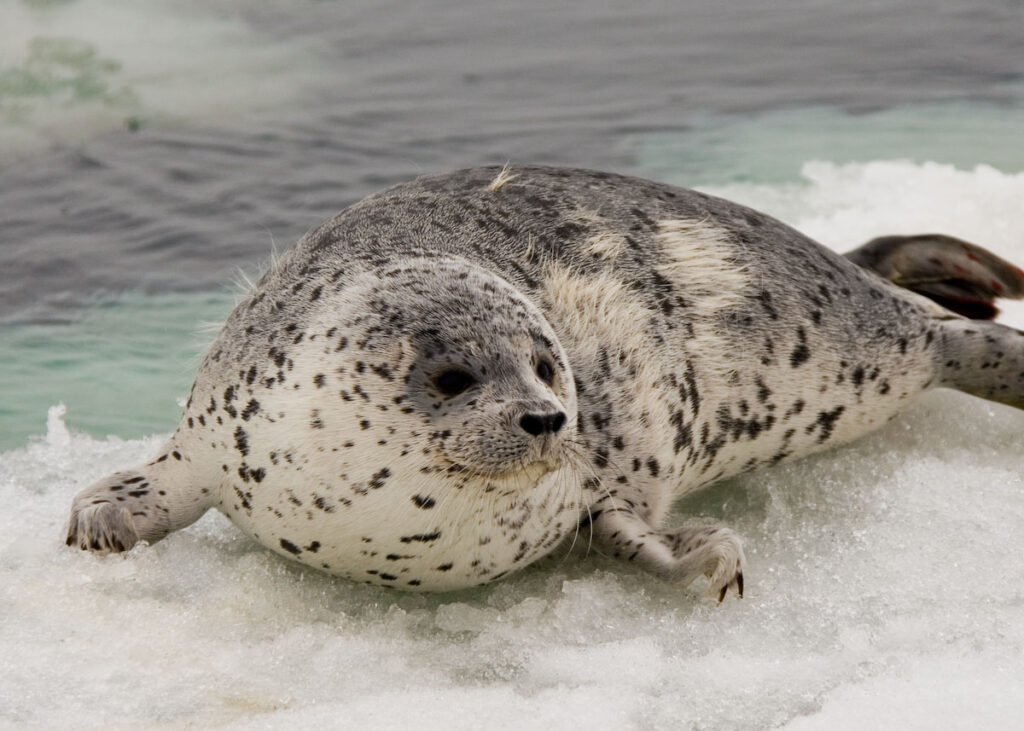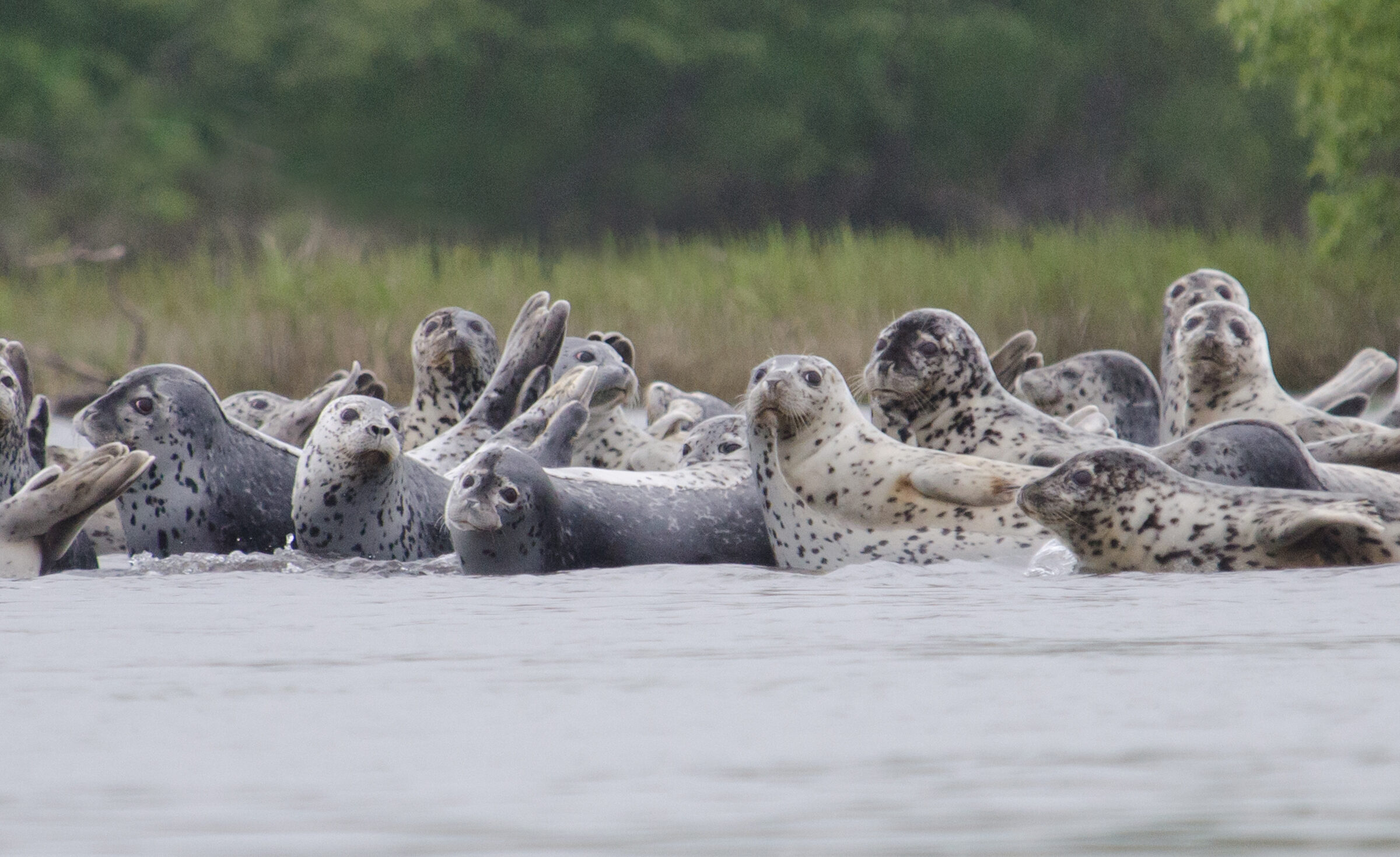This web page was produced as an assignment for an undergraduate course at Davidson College.
Researchers investigate differentially expressed proteins in wild and captive spotted seals.

The spotted seal (Phoca largha) is a marine mammal species found along the northern regions of the pacific ocean. Due to anthropologic factors such as poaching and habitat loss the seals have become endangered in China and Korea (Han et al., 2010). In the past decades China has taken measures to protect the spotted seal. The aquarium of china has undertaken a captive breeding program to support the Chinese population of seals. Currently, little over 1,000 seals in captivity make up half the population. However captive breeding programs are known to have drawbacks (Gao et al., 2015). Other species in captive breeding programs have been shown to adapt quickly to captivity and may become less suited to the wild. These changes can be the result of a smaller genetic pool or of a vastly different environment (Lynch & O’Hely, 2001). Researchers were curious as to how the captive spotted seals might be adaptively different from their wild counterpart and decided to use proteomic techniques to investigate.
Proteomics is the study of all the proteins an organism produces. An organism’s DNA contains code for different proteins. The way these proteins are selectively produced is referred to as protein expression. Both environmental and genetic factors can influence protein expression within individuals. Because of this, researchers decided to profile protein expression in wild and captive spotted seals to look for differences in these populations. By looking at protein expression instead of just the genetic sequence of the captive and wild seals researchers are able to see the impact of a captive environment and a restricted gene pool at the same time.
In this study researchers took blood samples from three wild seal pups and three captive seal pups. The wild pups were estimated to be roughly one month old while the captive pups were around four months old. Mass spectrometry analysis was used to identify 972 different proteins in the samples. There were some differences in protein expression between the two populations. The researcher found 51 differentially expressed proteins. 26 proteins were up regulated in wild seal, 7 were down regulated. There were also 8 proteins found only in the wild seals and 10 proteins found only in the captive seals. A significant portion of the upregulated proteins in the wild seals were related to phagocytosis, an immune function that allows for the destruction of pathogens. This indicates that the wild pups might be more resistant to disease. Proteins mediating carbohydrate metabolism were also upregulated in the wild seal pups.
To further understand these protein differences between the wild and captive seals, researchers used software to analyze protein-protein interactions between the differentially expressed proteins. They found that the heat shock protein, HSP90AB1 which was upregulated in wild seals, interacted with many of the other differentially expressed proteins. This led researchers to theorize that HSP90AB1 might be driven the differential expression of other proteins in the wild seals. HSP90AB1 is associated with increased stress. Since the wild seals are more likely to experience harsh conditions than the captive seals. This could increase HSP90AB1 expression which in turn could increase the expression of the other differentially expressed proteins.
The sample size for this study was very small with only 3 seals in each experimental group. A follow up study that includes a bigger sample size would help to confirm the results found in this study. Another avenue of research would be to test the hypothesis that the expression of HSP90AB1 is driving a lot of the differential protein expression in the wild seals. This would need to be proven experimentally by increasing the expression of HSP90AB1 in cells then measuring the expression of the other differentially expressed proteins. Despite the need for further research, the results from this paper do give important information about how captivity affects spotted seals. Since it appears the captive seals have a less responsive immune system due to the down regulation of immunity associated proteins, we now know that the seal caretakers should take more precautions against disease and look for way to boost immunity in captive seals. This information can improve the health of the population of captive seals and make them better suited for release back into the wild in the future.
References
Gao, X. G., Han, J. B., Lu, Z. C., Zhang, P. J., & He, C. B. (2015). Sequence variation and gene duplication at the MHC DRB loci of the spotted seal Phoca largha. Genetics and Molecular Research: GMR, 14(1), 2055–2062. https://doi.org/10.4238/2015.March.20.15
Han, J.-B., Sun, F.-Y., Gao, X.-G., He, C.-B., Wang, P.-L., Ma, Z.-Q., & Wang, Z.-H. (2010). Low microsatellite variation in spotted seal (Phoca largha) shows a decrease in population size in the Liaodong Gulf colony. Annales Zoologici Fennici, 47(1), 15–27.
jomilo75. (2007). Young spotted seal III [Photo]. https://www.flickr.com/photos/jomilo75/493217036/
Lynch, M., & O’Hely, M. (2001). Captive breeding and the genetic fitness of natural populations. Conservation Genetics, 2(4), 363–378. https://doi.org/10.1023/A:1012550620717
Melling, T. (2014). Spotted Seals [Photo]. https://www.flickr.com/photos/timmelling/14620614900/
Tian, J., Du, J., Han, J., Bao, X., Song, X., & Lu, Z. (2020). Proteomics reveals the preliminary physiological states of the spotted seal ( Phoca largha ) pups. Scientific Reports, 10(1), 18727. https://doi.org/10.1038/s41598-020-75759-2
© Copyright 2020 Department of Biology, Davidson College, Davidson, NC 28036.
